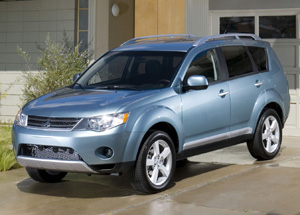
OKAZAKI, Japan – Long famous for its rugged body-on-frame SUVs and Eclipse sports car, the latter of which supposedly has higher name recognition than the brand itself, Mitsubishi Motors Corp. is looking to dig itself out of a hole in the U.S. by shifting focus to the hottest product trend in the industry: car-based utility vehicles.
Although the Outlander arrived in the U.S. just over three years ago, the cross/utility vehicle had been sold in Japan as the Air Trek, pre-dating the arrival there of Toyota Motor Corp.’s RAV4, the first compact CUV in the U.S.
But the Outlander never achieved the RAV4’s success in the U.S., or that of any other competing small CUV, and this year is running last in sales in Ward's Small Cross/Utility Vehicle segment.
For the ’07 model year, Mitsubishi has redesigned the Outlander with hopes the vehicle will propel the company out of a U.S. sales slump that has lasted the better part of the decade.
While the new CUV is taking hold in Japan, outselling Toyota’s latest-generation RAV4 by a small margin, time will tell if the downtrodden Japanese auto maker can pull a similar trick in the U.S.
The new Outlander once again rides on a passenger car-based unibody platform, but Mitsubishi engineers have revised the chassis, increasing dimensions slightly to address the perception the CUV is too compact.

While the Outlander retains its MacPherson strut-type suspension up front and a multi-link suspension in the rear, the underbody has been redesigned so the vehicle’s track now is 1.8 ins. (4.5 cm) wider in front and 1.4 ins. (3.5 mm) wider in the rear.
The integral frame has been strengthened, as well, with torsional and flexural rigidity both gaining vs. the current model, Mitsubishi says.
The Outlander also has a larger wheelbase than before, 105.1 ins. (267 cm) vs. 103.3 ins. (262 cm), and is 3.7 ins. (9 cm) longer. Roof rails raise the overall height by 1.4 ins. (4 cm); without roof rails the ’07 Outlander is 0.2 ins. (0.5 cm) shorter than the outgoing model.
Mitsubishi is counting on the vehicle’s aluminum roof to appeal to buyers who are skittish about buying utility vehicles because of their propensity to roll over.
The auto maker says the lightweight material is three times more effective than a more common hood application, keeping the Outlander’s center of gravity lower and reducing body roll in cornering.
U.S. buyers have only one powertrain, a 3L SOHC V-6. Executives say a 4-cyl. model could be a future possibility, pending the sales performance of the V-6 Outlander.
The switch to a V-6 bumps engine output impressively: 220 hp and 204 lb.-ft. (277 Nm) of torque vs. the often wheezy-feeling 162 hp and 160 lb.-ft. (217 Nm) of torque available from the outgoing Outlander’s 2.4L 4-cyl.
The horsepower still is nowhere near that of the new Toyota RAV4 V-6, a class-leading 268 hp, but is competitive, surpassing the Hyundai Tucson and Santa Fe, Jeep Liberty, Kia Sorento and Chevy Equinox – all with V-6s.
One of the new Outlander’s closest horsepower competitors is the luxury BMW X3 (currently 225 hp, but bulking up for ’07).

In an effort to infuse some of the Eclipse’s sporty DNA, Mitsubishi has equipped the Outlander with a standard 6-speed automatic transmission, it’s first ever and one of the few 6-speed automatics in the segment. The Outlander XLS trim adds steering-wheel paddles to enable sequential manual shifting between the six ratios.
In a test of the paddles here, shift response time is quick, although some pre-production models’ transmissions were experiencing technical issues, Mitsubishi says, leading to slight delays in upshifts.
Keeping in line with Mitsubishi’s desire for a sporty CUV, steering is tight and concise at almost any speed and the suspension stiff, but still forgiving over minor pavement abnormalities.
Buyers will be able to choose between front-wheel-drive or all-wheel-drive models. While most auto makers have moved toward full-time AWD systems, Mitsubishi’s All-Wheel Control, which incorporates stability control and traction control systems, is driver selectable via a dash-mounted dial.
The Outlander’s interior may make or break the vehicle and is one area that cannot be wholly assessed, as interior plastics in pre-production models driven here weren’t textured the way plastics in salable Outlanders will be.
However, overall interior design is appealing, with aluminum-toned accents on black being appropriately sporty.
Mitsubishi plans to use the Outlander’s now-you-see-it, now-you-don’t third row, available on the top trim, as a selling feature, but tests of the seat here reveal it to be clunky and complicated.
Raising the seat involves affixing small straps to lift it from its well. Fewer fussy steps and a lighter seat, or some type of spring-loaded assist, are needed.
Exterior styling, while derivative of many CUVs, is sleek and appealing. The jellybean-ness of the Outlander’s front is tempered by thick wheel-well flares and squared rear roofline.
The Outlander is available in two trims: LS and XLS. The LS seats five and has six standard airbags and an underfloor storage compartment.
The XLS adds, among other features, the hideaway third row, automatic climate control and a Bluetooth hands-free phone link with voice recognition.
Options include a navigation system, rear-seat DVD entertainment system and a Rockford Fosgate 650-watt 9-speaker audio unit integrating Sirius Satellite Radio (six months free service included).
The Outlander is an appealing entrant in the small CUV category, with above-average power and features. The hard part for Mitsubishi will be figuring out how to sell it. After all, “the soul of a sports car” tagline already is taken.
The ’07 Mitsubishi Outlander goes on sale in November in the U.S. Pricing will be announced closer to the on-sale date, but a well-equipped model is expected to start in the low $20,000-range, Mitsubishi says.



